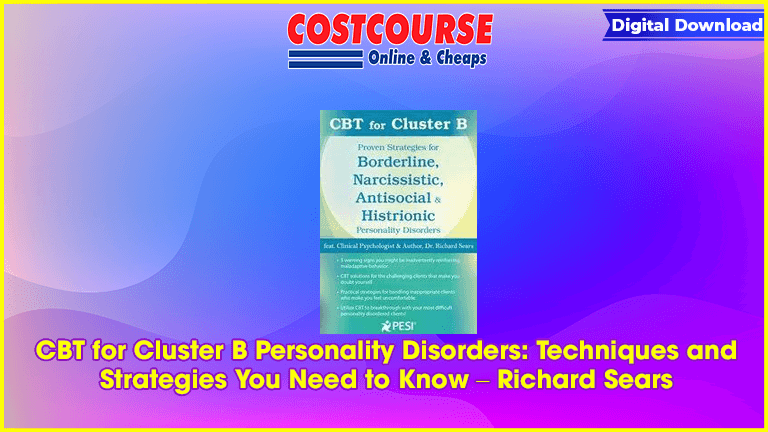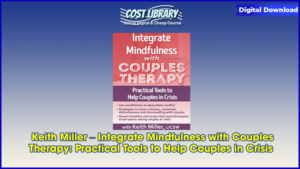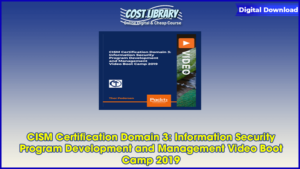Clients with cluster B personality disorders (borderline, antisocial, histrionic, and narcissistic) can be amongst the most challenging for therapists. Clinicians who are not properly trained can inadvertently make clients worse, and can even put themselves at risk for licensure board complaints.
CBT for Cluster B Personality Disorders: Techniques and Strategies You Need to Know – Richard Sears
However, when equipped with a deeper understanding of these disorders and the most effective principles and techniques, it can be extremely rewarding to witness the positive ripple effects that occur in these clients and their families.
In this recording, join clinical psychologist and author Dr. Richard Sears for a compassionate yet direct approach for working with these individuals using cutting edge, practical interventions that are grounded in theory.
You’ll learn:
How even the most frustrating, maladaptive behaviors get conditioned and reinforced over time (and what to do about it)
How recognize and interrupt unhealthy thinking patterns
Strategies for breaking free of struggles with thoughts, feelings, and unhealthy behaviors
Skills for managing stress, pointers for managing stressful sessions, etc.
How to avoid getting “sucked in†or hooked into the drama, “crisis of the weekâ€
How to model presence with distress and emotional chaos
With solid principles and detailed case examples, Dr. Sears will bring these concepts and methods to life with passion and humor, giving you practical take-aways to use in your very next therapy session!
Differentiate diagnostically between the four Cluster B personality disorders to accurately inform the treatment planning process.
Utilize treatment interventions based in cognitive and behavioral approaches, including exposure, chain analysis. ABC records and challenging distortions, for clients diagnosed with personality disorders.
Recognize and address potential clinical issues including crisis management, countertransference, boundary setting and self-care.
Implement mindfulness-based interventions to increase clients’ psychological flexibility and decrease emotional intensity.
What You Need to Know about Cluster B Diagnoses and Approaches
Diagnostic criteria: borderline, antisocial, histrionic, narcissistic personality disorders
Key features of each disorder – differential diagnosis considerations
Top indicators of PD you won’t find in the DSM-5®
5 things you probably never knew about cluster B personality disorders
How to avoid judgment and labeling and its importance
CBT Treatment Strategies and Techniques for Cluster B – Your Guide to Practical Application
Behavior – How to Approach Maladaptive Behavior, Self-Sabotage, Manipulation and Attention Seeking
How to shift behaviors that have been conditioned over a lifetime
Disrupting reinforcement
5 things you may be doing that actually reinforces maladaptive behavior
Practical application of classical and operant conditioning concepts
Roots of behavioral therapy
Psychoeducation: Increase clients’ insight into how their behavior is reinforced
Exposure techniques: Build distress tolerance and momentum toward healthier choices
Chain analysis: How to address a client’s feelings of hopelessness, improve awareness and identify precipitating factors and choice points
Case study – Sam, The Man Who Blames Everyone Else
Cognitive – How to Recognize and Interrupt Unhealthy Thinking Patterns
How to address negative beliefs about treatment, the experience of negative emotion and getting better
How to adapt cognitive techniques specifically for Cluster B
ABC records and Challenging Beliefs Worksheets
Socratic dialogue
Common cognitive distortions
Why challenging your client’s thoughts can make things worse
Case study – Martha, The Woman Who Confused her Thoughts and Memories with Reality
Mindfulness and Acceptance – Break Free of Distressing Thoughts, Feelings and Behaviors
How to increase psychological flexibility, decrease emotional intensity, and focus on the bigger picture
Why mindfulness and relaxation are not the same thing
Mistakes with mindfulness – inadvertently encouraging avoidance
How to adapt mindfulness and acceptance techniques for Cluster B
Cognitive defusion: Stepping back from thoughts
Acceptance: Letting go of control
Mindfulness: Foster the ability to stay present
Observing the self: Develop a bigger sense of who you are
Identify values: Finding the “whyâ€
Take committed action
Case study – Arthur, the Loving, Self-Centered Father
Special Clinical Considerations for Personality Disorder Practitioners
Crisis management: Suicidal ideation/gestures, self-injury
Create a clear crisis management plan to keep clients safe and avoid personal liability
What you need to avoid – documentation considerations and more
5 signs you need to check your boundaries
Preventative measures – to avoid boundary violations and false reporting to licensure board
Strategies for recognizing and addressing countertransference – being honest without getting lost
Top 3 tips for staying present in session
Balance boundaries with compassion
Model presence with distress, not joining the emotional chaos
Internal messages – Not getting sucked in
Exercise: People that bother me








